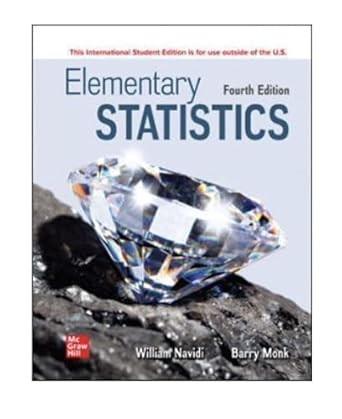
Get complete eBook Instant Download Link below https://scholarfriends.com/singlePaper/455933/ebookelementary-statistics-4th-edition-by-william-navidibarrymonk
"Elementary Statistics" (4th Edition) by William Navidi and Barry Monk is structured to introduce students to fundamental statistical concepts and methodologies. Below is a chapter-wise summary of the key topics covered in the textbook:
Chapter 1: Basic Ideas
Sampling: Introduction to various sampling methods and the importance of representative samples in statistical analysis.
Types of Data: Differentiation between qualitative and quantitative data, and levels of measurement.
Design of Experiments: Fundamentals of experimental design, including control groups, randomization, and blinding.
Bias in Studies: Identification and implications of various biases that can affect study outcomes.
Chapter 2: Graphical Summaries of Data
Graphical Summaries for Qualitative Data: Utilization of bar charts and pie charts to represent categorical data.
Frequency Distributions and Their Graphs: Construction and interpretation of frequency tables, histograms, and frequency polygons.
More Graphs for Quantitative Data: Exploration of stem-and-leaf plots, box plots, and time series plots.
Graphs Can Be Misleading: Discussion on how graphical representations can distort data interpretation.
Chapter 3: Numerical Summaries of Data
Measures of Center: Calculation and interpretation of mean, median, and mode.
Measures of Spread: Understanding range, variance, standard deviation, and interquartile range.
Measures of Position: Introduction to percentiles, quartiles, and z-scores.
Chapter 4: Summarizing Bivariate Data
Correlation: Analysis of the strength and direction of linear relationships between two variables.
The Least-Squares Regression Line: Derivation and interpretation of the regression line for predictive analysis.
Features and Limitations of the Least-Squares Regression Line: Understanding residuals, influential points, and the limitations of regression analysis.
Chapter 5: Probability
Basic Ideas: Foundational concepts of probability, including sample spaces and events.
The Addition Rule and the Rule of Complements: Techniques for calculating probabilities of combined events.
Conditional Probability and the Multiplication Rule: Analysis of dependent events and their joint probabilities.
Counting: Introduction to combinatorial methods such as permutations and combinations.
Chapter 6: Discrete Probability Distributions
Random Variables: Definition and properties of discrete random variables.
The Binomial Distribution: Characteristics and applications of binomial experiments.
The Poisson Distribution: Modeling the occurrence of events over a specified interval.
Chapter 7: The Normal Distribution
The Standard Normal Curve: Properties of the normal distribution and standardization of variables.
Applications of the Normal Distribution: Utilizing the normal model in real-world scenarios.
Sampling Distributions and the Central Limit Theorem: Understanding the distribution of sample means and its significance.
The Normal Approximation to the Binomial Distribution: Conditions and methods for approximating binomial probabilities using the normal curve.
Assessing Normality: Techniques for evaluating whether data follow a normal distribution.
Chapter 8: Confidence Intervals
Confidence Intervals for a Population Mean (Standard Deviation Known and Unknown): Constructing intervals to estimate population means under different conditions.
Confidence Intervals for a Population Proportion: Estimating the proportion of a characteristic within a population.
Confidence Intervals for a Standard Deviation: Methods to estimate the variability within a population.
Determining Which Method to Use: Guidelines for selecting appropriate confidence interval techniques based on data characteristics.
Chapter 9: Hypothesis Testing
Basic Principles of Hypothesis Testing: Formulation and testing of null and alternative hypotheses.
Hypothesis Tests for a Population Mean (Standard Deviation Known and Unknown): Procedures for testing claims about population means.
Hypothesis Tests for Proportions: Assessing claims regarding population proportions.
Hypothesis Tests for a Standard Deviation: Evaluating variability claims within a population.
Determining Which Method to Use: Criteria for choosing the correct hypothesis test based on data and research questions.
Power: Understanding the probability of correctly rejecting a false null hypothesis.
Chapter 10: Two-Sample Confidence
Intervals
Confidence Intervals for the Difference Between Two Means (Independent and Paired Samples): Estimating differences in means from two distinct or related groups.
Confidence Intervals for the Difference Between Two Proportions: Estimating the difference between two population proportions.
Chapter
11: Two-Sample Hypothesis
Tests
Hypothesis Tests for the Difference Between Two Means (Independent and Paired Samples): Testing for significant differences between group means.
Hypothesis Tests for the Difference Between Two Proportions: Assessing differences between two population proportions.
Hypothesis Tests for Two Population Standard Deviations: Comparing variability between two populations.
The Multiple Testing Problem: Addressing issues arising from conducting multiple statistical tests.
https://scholarfriends.com/singlePaper/455933/ ebook-elementary-statistics-4th-edition-by-williamnavidibarry-monk
